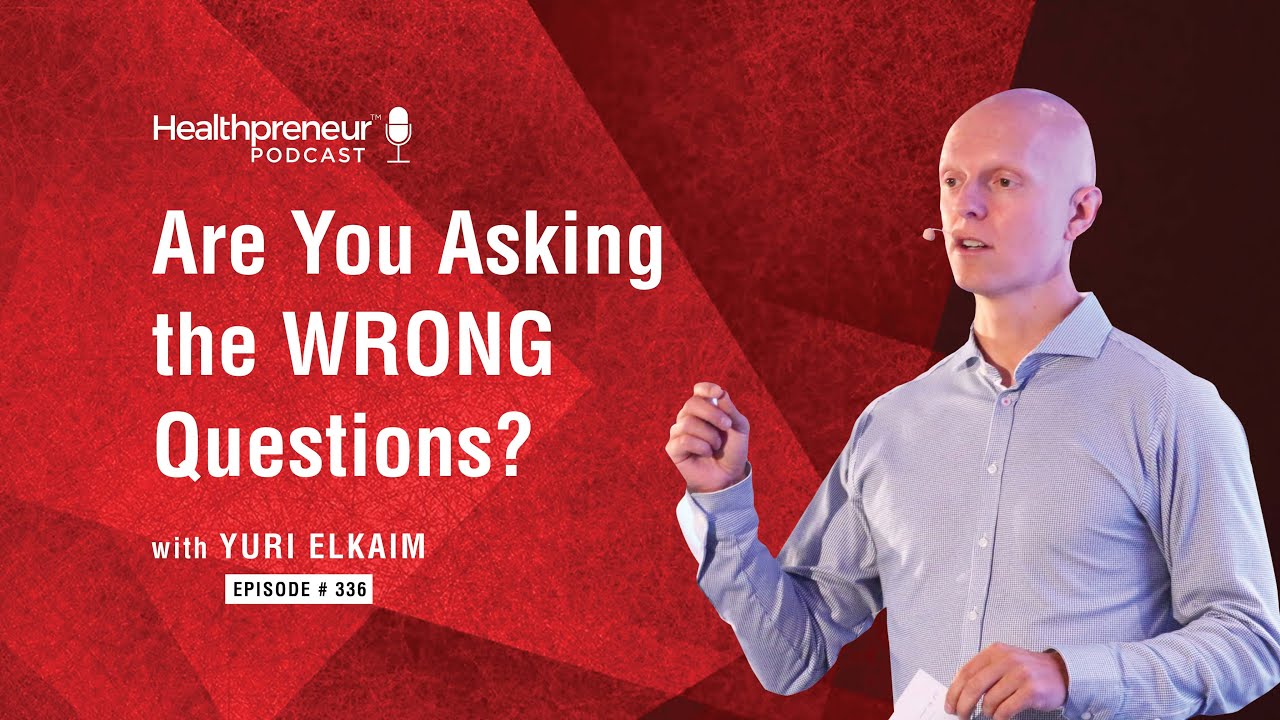How to Create Content That Generates Clients (Not Just Eyeballs)
How do you create content that doesn’t just get eyeballs, but actually generates business, that leads to clients enrolling with you?
A little bit of context here, as you may or not know, I’ve got a health and fitness business in addition to Healthpreneur. The health and fitness business has been online since 2006, and right now our blog gets almost 1 million unique visitors per month.
I don’t say that to brag, because there’s nothing to brag about there.
And just to give you some context, some of the top marketers in the world, like Seth Goden, his website gets about half of that type of traffic.
There are obviously other bloggers that get a lot more traffic, but I share this with you because that’s been a long, long process and it doesn’t necessarily mean that we’re raking in the dough from that type of content platform.
There are definitely ways you can monetize it and we’ve done a great job at that, but I want to let you know that if we want to impact people, it’s not really going to happen when someone lands on your site. An average time on site is about a minute and 21 seconds. That’s not how we’re going to change people’s lives.
We’re in a world where information is ubiquitous. People want transformation they don’t want information.
So, with that said, how do we create content that is going to stand out, is going to really get people to sit up in their seats and be like, “Wow, this makes a lot of sense, I’m interested in working with this person?”
Two way of Creating Content
There’s two ways of creating content. There’s the way of the content publishing SEO platform type of game, where you publish crazy amounts of content, all based around key word research.
That’s exactly what we did with our health and fitness blog. And that’s doable, but it just takes a lot of work, a lot of manpower, and a lot of time.
You’ll get more organic search, you’ll get found in Google, you’ll get rankings, all that kind of stuff. And people seem to really, pride themselves on that. It’s kind of like a narcissistic ego boost more than anything, and I say that very hypocritically, coming from my perspective.
The second way to create content is to say you know what, I don’t care about any of that stuff. I’m going to create content that I want to create, that is going to hopefully help my audience.
It’s not going to be focused on SEO, it’s not going to be focused on keyword research.
Itt’s going to be focused on questions and concerns that my people have. And I’m not going to worry about getting back links, singeing all sorts of nonsense to do that. I’m going to create content for my existing audience, instead of creating content to hopefully get new people into my tribe.
If you already have a good process in your business, you should be generating leads through other means, not just creating videos like this.
SEO Content Marketing
Those are the two different ways we can do it, and when we’re looking at creating a content platform, which is heavily based around SEO, we’re using a methodology called teach to teach, which is you’re giving away everything because you have to.
The 101 ways to use coconut oil, like who cares about that stuff, right? Or how to lose weight, the exact step by step plan. When you are creating content that is based on SEO, you have to make it the best out there, which means you have to give way everything.
Not only is that important to get found in Google, but it’s important for people to share it, and link to it. So it’s just a game that is okay to play, but a lot of times it doesn’t lead to anything else, because you’ve given away all of your stuff in the 5,000 word blog post.
Teach to Sell Content Marketing
The alternative is using what we call the teach to sell method of creating content, which is sharing the what and the why, but not so much of the how.
In doing so you build desire, you give insights. Obviously you provide value, but you build desire for people to move to the next step with you. And that is how you take people from just consuming content to going to the next level with you in your coaching for instance.
So what does that look like? What does teach to sell look like?
We focus more on the what and the why, instead of the how. We don’t talk about the exact step by step process to do everything that the blog post or the title might make it out to seem.
And, just so I’m clear, we’re not holding anything back, we’re not duping people.
We’re just approaching it in a slightly different manner, instead of giving away the farm. Okay? Because if you give away the farm, you’ve scratched all the itches. And if there’s no more itches to scratch, they’re good, they don’t need to go any further with you, and that’s something that we don’t want to have happen.
So, what we want to focus on is sharing content in a way that is not just about what you know, but what you believe. What do you stand for? What do you stand against?
How can you create content that is polarizing, that is going to piss some people off, and that is going to rally other people?
If you share more of this type of content I guarantee you, you will be a lot more successful with what it is you’re offering.
The key distinction here is that you’re creating content for your existing audience, not trying to find new people through Google keyword search. That’s a big distinction, because what we’re doing here is we’re creating Kool-Aid that you want your tribe to drink. The more Kool-Aid they drink, the more they buy into your philosophy.
And that’s the key if you want an easier time enrolling people who believe in your approach to life, business, whatever it is, that is the secret.
Examples of The Teach To Sell Method
Podcasting
Let me give you an example of a podcast. I should say why do 99% of people start a podcast? They start a podcast because they think that having a podcast is going to generate new leads, is going to get them in front of new eyeballs. And that’s one way of looking at it, and it definitely can happen.
But I want to make an alternative argument here, is that having a podcast is the ultimate way to provide more Kool-Aid to your existing audience.
When you have someone who is opted into your list, or who follows you on social, and now they listen to your podcast every week, you have them on demand. They’re listening to you 30, 45 minutes a week, and you’re simply just sharing your stuff. Not just what you know, but what you believe, your philosophies, your perspectives, your opinions. And these are the things that are going to build a ravenous tribe around you.
So, the more you share that type of content, the more successful you’re going to be in enrolling the right people into your business.
It’s not about playing the SEO game. It’s about playing the I’m going to be a service game, but doing so in an intelligent manner. Teach to sell, versus teach to teach.
YouTube
Final little example Ill share is this YouTube channel. This video is on, is our Healthpreneur YouTube channel.
Right away, when we started Healthpreneur I didn’t want to create a YouTube channel. I didn’t want to do the whole thing, because we already had one for my health and fitness business and it’s a lot of work. We have 215,000 subscribers, 1,000 videos. I don’t want to do that.
What I decided to do with this channel was I said, “I just need somewhere to house the videos. I don’t care if they get ranked, I don’t care if people find them. I just need somewhere to house the videos and we can take these videos and put them on our blog and share them on social.”
So, as of this video recording I believe we have a whopping three subscribers on this YouTube channel.
Do I care about that? No, because if you’re seeing this you’re probably in our tribe already. You’re not somebody who’se new, who will have no clue who it is, not in our tribe.
It’s about sharing content with our existing tribe of people to further help you guys, to further bond and build that relationship with you, so eventually maybe you say “hey, this guy Yuri, he goes off on tangents, he’s a bit crazy. He keeps walking his dogs, he’s always wearing the same sweater. But, yeah, it kind of makes a lot of sense. And I think at some point when I’m ready to move forward, he and Healthpreneur are the first choice”.
And that’s what you want to be. Everybody you come into contact with wants you to be their monopoly.
Being The One
But what I’ve recognized is that, and this has happened for me as well, is we want one person, one business, one company to solve to be our monopoly.
If someone cuts your lawn, do you want a new person, a different company every single week, who doesn’t know your lawn, who doesn’t know your landscape?
If you want someone to clean your house, do you want a new cleaning person every single time, or would you rather have the same person who understands your house, who knows the nooks and crannies?
It makes a lot more sense to have one person, and this is important. So you want to be that one person for your audience, and the more you can share your content in the way that I’ve shared it here, I believe the more successful you’re going to be.
Now, if you’d like an example of how this can all work, check out our webinar, The 7-Figure Health Business Blueprint.
If you haven’t yet attended it’s an amazing 70 minute presentation, and you’ll see exactly what I’m talking about. You’ll see exactly how you can take what you know and turn it into a very simply predictable and profitable health coaching business.
If you’re just starting off, or scaling up, this can help you in a big way.
So if you’d like to join us for that, it’s completely free to attend. To join us, simply click on the link below.
Free Online Training: 7-Figure Health Business Blueprint
Hope you’ve enjoyed this video. Hope this found you well. And, I look forward to seeing you soon.
If you enjoyed this episode, head on over to iTunes and subscribe to Healthpreneur™ Podcast if you haven’t done so already.
While you’re there, leave a rating and review. It really helps us out to reach more people because that is what we’re here to do.
Related posts
July 14, 2019
How to Get Your First Coaching Clients (And Big Announcement)
Hey, hey, hey Healthprenurs!…
October 19, 2018
Why Sharing Your Authentic Voice Matters More Than Ever with Adrienne Nolan Smith
Have I got a treat for you,…





